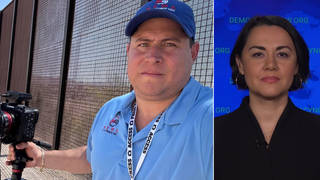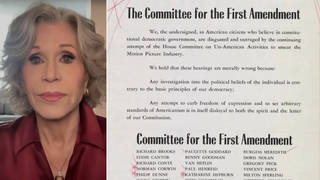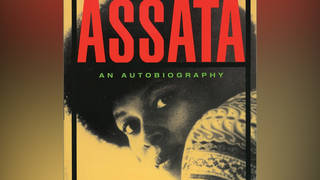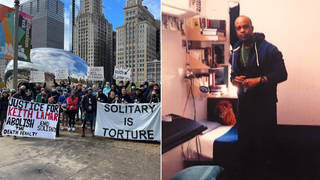
Topics
Guests
- Staughton Lyndlongtime historian, peace activist and lawyer. A new edition of his 2004 book, “Lucasville: The Untold Story of a Prison Uprising” is being published in March.
Four prisoners in the supermax Ohio State Penitentiary have launched a hunger strike to protest what they call their harsh mistreatment under solitary confinement. The prisoners — Bomani Shakur, Siddique Abdullah Hasan, Jason Robb and Namir Abdul Mateen — were sentenced to death for their involvement in the 1993 prison uprising in Lucasville, Ohio. For over 17 years, they have been held in 23-hours-a-day solitary lockdown. On Monday, the four began refusing to eat meals until they are moved out of solitary confinement and onto death row, where they say they will get better treatment. We speak with longtime peace activist, historian and lawyer, Staughton Lynd. In 2004, he wrote the definitive history of the 1993 Ohio prison uprising at Lucasville.
AMY GOODMAN: Four prisoners in the supermax Ohio State Penitentiary have launched a hunger strike to protest what they call their harsh mistreatment under solitary confinement. The prisoners — Bomani Shakur, Siddique Abdullah Hasan, Jason Robb and Namir Abdul Mateen — were sentenced to death for their involvement in the 1993 prison uprising in Lucasville, Ohio. For 11 days, over 400 prisoners staged a riot against prison conditions. Nine prisoners and a guard were killed. It was the bloodiest prison riot since Attica. Hasan and Robb were sentenced to death, despite helping negotiate an end to the uprising, and supporters say all four were wrongly convicted.
For over 17 years, they’ve been held in 23-hour-a-day solitary lockdown. On Monday, the four began refusing to eat meals until they’re moved out of solitary confinement and on to death row, where they say they’ll get better treatment. In a statement, one of the prisoners, Bomani Shakur, said, quote, “We have undergone penalty on top of penalty; been kept from fully participating in our appeals, from touching our friends and families; denied adequate medical treatment; and so many other things that are too numerous to name. In a word, we have been tortured.”
For more, we’re going to Ohio, where we’re joined by the historian, lawyer, labor activist and Quaker pacifist Staughton Lynd. In the ’60s he taught history at Spelman College in Georgia alongside Howard Zinn and helped direct the Mississippi Freedom Schools. In April 1965, he spoke at the first March on Washington against the Vietnam War and became an early leader of the antiwar movement. Since the 1970s, Staughton Lynd has focused extensively on labor and prison issues. In 2004, he wrote the definitive history of the 1993 Ohio prison uprising at Lucasville.
Staughton Lynd, welcome to Democracy Now! This is very bleak, to say the least, to have these four prisoners say that they would rather be on death row than where they are now. For an audience around the world who is not familiar with the Ohio State Penitentiary, describe why these men are in prison and why they’re in this prison.
STAUGHTON LYND: Well, they are in prison for various crimes, but they are all in this prison because of their alleged leadership of the 1993 uprising. And they are held in more restrictive confinement than the more than 100 other death sentence prisoners in the same prison. Now, why is this? It’s precisely because the system thinks of them as leaders. So, it will let them watch television. They even let Bomani Shakur use a typewriter. But what they don’t let any of the four men do is to be in the same space as another human being other than a guard at the same time. And this means that while other death sentence prisoners can wander about the pod, can have collective meals outside their cells, and especially can have semi-contact visits with their friends and families, the four are always obliged to encounter the world either through a solid cell door or, when they go out on a visit, through a solid pane of glass. So that, again, Bomani has a niece and nephew aged eight and three that he loves and would wish to touch. If he were on death row, he could do that. But he’s been told by the prison authorities he will never be on death row, because they’re going to keep him in social isolation until they kill him.
AMY GOODMAN: Meaning he is on death row, but just not physically. He is sentenced to die, but he is not actually on the row.
STAUGHTON LYND: Precisely. And so, these men feel that they’ve been given the ultimate punishment of death and then something more.
AMY GOODMAN: Now, to understand where they are, how this prison was even built, what a supermax means, let’s go back to, well, the subject of your book, Lucasville: The Untold Story of a Prison Uprising. What happened in 1993?
STAUGHTON LYND: Well, in 1990, at Lucasville, which was Ohio’s maximum-security prison — not supermax, maximum — there was a dreadful incident and, I would add, an ambiguous incident, perhaps not completely understood, where a black male prisoner followed a white teacher into the women’s restroom, and as white officers sought to break down the door, with all sorts of rape fantasies in their minds, the prisoner cut the woman’s throat. And that triggered a so-called Operation Shakedown. A new warden was brought in. There were lines painted on the floor on which people had to march to meals. There was a special post office box set up by the warden so that prisoners could inform — that is to say, snitch — on one another. And what has always seemed to me perhaps the most communicative detail, prisoners were allowed one brief telephone call at Christmas time per year.
So, in 1993, as you said, Amy, more than 400 prisoners took over a major cell block in the prison. And I believe their objective was to catch the attention of Columbus and get the state prison administration to intervene so that Muslim prisoners would not be inoculated with a TB shot that they claimed contained phenol, which they said had alcohol in it and, in their opinion and the opinion of their religious advisers, was not permitted for them as Muslims. But what happened, I think, was when this intended nonviolent occupation was initiated, all the pent-up feelings of prisoners expressed themselves. Both guards and prisoners were badly hurt. Eight guards remained as hostages. One of those hostages was murdered. And so, there was a negotiated surrender, in which two of the men now sentenced to death took part, but their reward for what they did to try to save lives in that way was themselves to be sentenced to death. That’s the background.
And there’s no question, a federal judge has explicitly held that the supermax in Youngstown, where my wife and I live, was built as a response to that uprising. In fact, I once had the opportunity to ask the director of the Ohio prison system why there was no outdoor recreation at the Youngstown supermax, because many states have this supermax kind of prison, but most of them have some form of dog run, a concrete well, out of doors, where prisoners can feel rain on their face and see the sun. Youngstown, no. So I said, “Director Wilkinson, how come no recreation at Youngstown?” And he said, “Well, the Lucasville riot began on the recreation yard.” So, there’s no question that the very building of this prison was a reaction — an overreaction — to what happened in 1993.
And these men are being held in total social isolation, where they can never be in the same space as any other human being except a prison guard, because it’s feared they would once again exercise their charismatic talents and lead some sort of uprising. But as Bomani again emphasizes whenever we speak with him, how is his ability to touch the hand of his eight-year-old niece a security threat? We feel the isolation is a violation of the Eighth Amendment prohibition on cruel and unusual punishment, the more so because you can see the usual punishment by looking at the man in the next visiting booth.
But there’s a second issue, which is that every year there is a so-called security review for these men. Now, this should be important to every American citizen, because it is precisely what, according to the New York Times, the Obama administration is going to propose for the several dozen prisoners at Guantánamo that it feels it cannot bring to trial. Why can it not bring them to trial? Because they are alleged to have committed crimes to which they’ve confessed under forms of torture that a federal court would not permit to be put on the record. So what do you do with them? Well, the President is saying, we’ll keep them at Guantánamo indefinitely, but every year we’ll give them a security review. Now, what does that mean? The prisoner will say, “I’ve had no misconduct in the past year.” And the prison administration will respond, “Well, of course you haven’t. We’ve had you locked down. That doesn’t give us any indication of how you would behave if you were at a lower security level or, in the case of Guantánamo, if you were freed.” So I think this is smoke and mirrors. I think it’s hypocrisy. And I think it should be condemned in the strongest terms by the American people and the American legal community.
AMY GOODMAN: Staughton Lynd, how have they organized this hunger strike, if they can’t communicate with each other?
STAUGHTON LYND: Well, they don’t cell phones like the prisoners in Georgia. Sometimes it’s possible to holler to a person. If you’re on your way to your solitary rack, but you’re not too far from the cell of another man, you can sometimes yell to him. Of course, you’re going to be discrete in what you say. There is also the possibility of writing from prisoner to prisoner. Prison has the right to review that mail, doesn’t always do so. But as you know, I’m sure, from other interviews you’ve conducted, prisoners are extraordinarily ingenious when it comes to, for example, fishing, which is the practice of writing something, tying it to perhaps a string that you’ve torn from a sheet, and shooting it to a prisoner across the way. To prevent that from happening, the Ohio State Penitentiary put special strips of metal up around the sides and at the bottom of cells. But in whatever ways — and I haven’t inquired too closely — the men have managed to be in touch about, well, we’re going to start on such-and-such a day, Monday, January 3rd, and are proceeding.
AMY GOODMAN: This is the statement of Bomani Hondo Shakur, one of the four who are participating in this hunger strike. He says, “Before I speak my piece, let me make one thing perfectly clear: I don’t want to die. I want to live and breathe and strive to do something righteous with my life. Truly. For the past 16 years, however, I’ve been in solitary confinement, confined to a cell 23 hours a day for something I didn’t do and, speaking honestly, I have gone as far as I’m willing to go. […]
“I realize that for some of you the thought that an innocent man could be sent to prison and ultimately executed is inconceivable. But it happens. […]
“A few months ago, a federal judge recommended [that] my case be dismissed, which effectively moved me one step closer to being executed. It’s hard to explain how this made me feel, but upon hearing the news I immediately thought that a mistake had been made and that my attorney had somehow misunderstood the judge’s ruling. As it turns out, I was the one who misunderstood. Indeed, I have been 'misunderstanding' things all along.”
Those are the words of Bomani Hondo Shakur. Staughton Lynd, if you could respond?
STAUGHTON LYND: Well, the judge was a magistrate who actually didn’t want to dismiss it, except in the sense of denying his petition for habeas corpus. But since you’ve asked, Amy, let me explain that Bomani’s leading issue on appeal has to do with what is called discovery. That is, the right of a defense lawyer to obtain certain information from the prosecution before trial. And under a Supreme Court case called Brady v. Maryland, the prosecution is supposed to give the defense any information that might be exculpatory. Here’s what the prosecution did in Bomani’s case. It gave his lawyer a list of names, many names, more than 50. It gave his lawyer a list of interview summaries, like three or four sentences. But it said, “We can’t tell you which prisoner gave which summarized interview, because that would be a security threat.” Now, I couldn’t imagine a federal court feeling that that was a legitimate way to provide discovery, but the judge, the magistrate, managed to do it. I mean, I had in my hands a statement by another prisoner in which he said, “I was there. I watched the events for which LaMar,” as he called him, “was convicted. LaMar had nothing to do with it.”
AMY GOODMAN: And LaMar is?
STAUGHTON LYND: Is Bomani Shakur.
So, I think what these prisoners are feeling — in fact, Bomani says this elsewhere in his statement — “All these long years, 15 years, we’ve been told, well, when you get to federal court, you really get justice.” And now Bomani is saying, “But I misunderstood. That ain’t the way it is. And I have to find some way to take my life in my own hands and protest.” And that’s what this hunger strike is. And we’ve all thought, of course, about the Holocaust and people being led to the gas chambers, and “Why didn’t they do something?” I’m not sure what they were supposed to have done, but “Why didn’t they do something?” And these men are trying to answer that question by saying, “OK, we know no way to protest other than to harm ourselves by going without food. But if that’s the one way that’s open to us, that’s what we’re going to do.”
AMY GOODMAN: Staughton Lynd, when did you last visit them?
STAUGHTON LYND: Let’s see. This is Tuesday. Last Wednesday, we visited Bomani Shakur. And a week ago Monday, we visited the fifth man, who they took out of the supermax because he had become severely depressed, and, my wife and I believe, the authorities were afraid that he would commit suicide. He’s at another Ohio prison. But we visited both him and Bomani, and we’ve been on the phone with two of the others.
AMY GOODMAN: And he is George Skatzes?
STAUGHTON LYND: He is George Skatzes.
AMY GOODMAN: Uh-huh. And they are afraid he will commit suicide before they execute him?
STAUGHTON LYND: That’s right. We had a guy who did try to commit suicide, and they took him to the local hospital, they nursed him back to life, and then they executed him a week later.
I should tell your viewers that Ohio is something else. Ohio is the only state of the 50 that executed more people in 2010 than in 2009. Ohio is now second only to Texas in the number of people that it executes. Ohio is doing its best to execute one man every month, but there were some clemency decisions, so they only killed eight in 2010. But, you know, Saint Paul says something in one of his letters about “Come over to Macedonia and help us.” And this is Ohio saying, “Hey, we need some help.” This state is off the rails.
AMY GOODMAN: Can you talk about prisoner activism, from Georgia, the recent —- you were referring to the cell phone protest -—
STAUGHTON LYND: Yeah.
AMY GOODMAN: — how they coordinated the protests in many of the prisons, to Ohio?
STAUGHTON LYND: Well, I remember going to a conference years ago where supermax prisons were being discussed, and I said something about how it was important for a lawyer, you know, to take leadership from the prisoners themselves. And another lawyer there said, “What are you talking about? You can’t do anything in a supermax prison.” And, of course, there’s a commonsense basis for that observation, but human beings are human beings.
And if I could take a moment, I would like to describe one of the most extraordinary experiences Alice and I have had with this group of people, because we took a class action to the Supreme Court of the United States on behalf of all the prisoners at the Ohio supermax, and at one point the judge was leaning on us to negotiate a certain — to accept a certain settlement proposal that the state had made. And we said, “Well, we’re sorry, your honor. We have to go to our clients and talk with them.” Well, how can you talk with your clients in a supermax prison, where they’re not allowed to be together? So, the prison gave us access to an empty cell area. Each of the — oh, I don’t know, maybe 15 at that point — plaintiffs, representing different kinds of problems, was put in a separate cell. Every one had his food slot open, so that they could put their arms through to vote. And the question came up, “Well, should we accept the state settlement proposal?” And all these arms came out for no. And then I said, “Well, in fairness, let’s see if anyone is for it.” And one arm came out.
And it happened that this arm was from a man who had been sent to the supermax in the following way. He was standing in the chow line at Lucasville. Someone came up behind him and hit him with a very heavy — if I say “spatula,” you’ll think of a little tin thing, but I’m talking industrial cooking, large iron spatula. And Kevin Roe — that was his name — was taken to the infirmary. When he was well enough to leave the infirmary, they sent him, not the guy who had hit him, to the supermax, which made quite an impression on our judge.
But at this particular meeting, after Kevin’s arm came through to vote yes, I said, in my most Quaker manner, “Kevin, didn’t you just finish voting no?” And a voice came from the upper range, “Well, I guess that’s what happens when you’re hit over the head with a spatula.” And the whole place collapsed in laughter. And what was so interesting and so moving was that many of these men had never met each other. And yet, they were able to form a common position in response to a rather complex issue on which a lot depended.
So, I think — you know, Viktor Frankl wrote a book called Man’s Search for Meaning about his experience in a concentration camp. He said, “Human beings always have a choice.” There’s always one — more than one thing you can do. And I think that’s true of supermax prisoners, as well. We’ve — because of our lawsuit, we’ve corresponded with people all over the country — Pelican Bay and California, the South, the Midwest — and there are a lot of very bright people being held under very burdensome conditions. And when you’ve got nothing to do all day but think about ways in which you can try, with whatever difficulty, to respond, to fight back, it’s amazing how ingenious people can be.
AMY GOODMAN: How long will this group of men, the four men at Youngstown — how long will they be on this hunger strike, Staughton Lynd?
STAUGHTON LYND: Well, that’s a frightening question. One of the persons with whom we’re working is a professor at State University of New York, Binghamton, the director of graduate studies in sociology, and he has written a book about the Irish hunger strikes in the early 1980s, that many may recall, when Bobby Sands and about a dozen others starved themselves to death.
Now, I have been scratching the surface of reality. Alice and I are each — Alice is 80, I’m 81. We’re not part of a law office. It’s really difficult for us to initiate litigation. But there is a lawsuit waiting to be brought for these guys, and there’s a very good precedent from the Angola supermax in Louisiana. And my hope would be this: that after they had been on hunger strike for however long, it would be possible to hold a press conference and to say, “Human beings cannot do this forever. But as a supplementary means of struggle, we’re initiating the following lawsuit,” or it could be a petition to the director. As a matter of fact, if people are interested in a petition, there is a website, www.ipetitions.com — that’s lower case i, no dot, petitions dot com — where folks could go to sign a petition to the authorities. I hope that, whether it’s a lawsuit, a petition, committees of inquiry, whatever, there will be some supplementary forms of activity developed so that these guys can come off the hunger strike before they destroy themselves.
AMY GOODMAN: And in a sentence, Staughton Lynd, what their demands are?
STAUGHTON LYND: Their demands are to have the same privileges that other death-sentenced prisoners have, the opportunity to be around other prisoners for a certain number of hours in the week, and to have at least semi-contact visits with their loved ones.
AMY GOODMAN: Staughton Lynd, as we wrap up, you have been involved with activism, with your wife Alice, with the larger antiwar community, civil rights activism, your prison work over the decades. Today, in 2011, as we move into this new year, what gives you hope?
STAUGHTON LYND: Well, first of all, let me tell you what does not give me hope. I am not one of those standing in line to blame President Obama, because I feel we have failed to create sufficient grassroots pressure on the President from below. And I think back to the early ’60s when the civil rights movement was at least as disgusted with President John Kennedy and Attorney General Robert Kennedy as anyone could possibly be with President Obama at the moment, but we had a movement. We represented potential voters. And those politicians changed course.
And I think it’s — I don’t know if you can say this gives me hope, Amy, but at least it’s my strategy for 2011. Let’s concentrate on creating a movement down below. I mean, for example, if Obama suggests what I believe is an essentially Mickey Mouse procedure for evaluating the security status of enemy combatants at Guantánamo, I think we should light into him and say, “This ain’t going to do it.” And unless we do that, where do we leave him? He’s subjected to pressure from only one direction. And every negotiator likes to look across the table and say, “Well, you know, if it was just up to me, I might be able to agree with you. But they’d tear me to pieces out there.” We’ve got to create the movement down below. And I’m not talking about doing whatever MoveOn.org tells us to do on the internet. I’m talking about a genuine rank-and-file movement or a group of interlocking rank-and-file movements that puts out our demand for another kind of world.
AMY GOODMAN: Staughton Lynd, I want to thank you very much for joining us.
STAUGHTON LYND: My pleasure, Amy.











Media Options